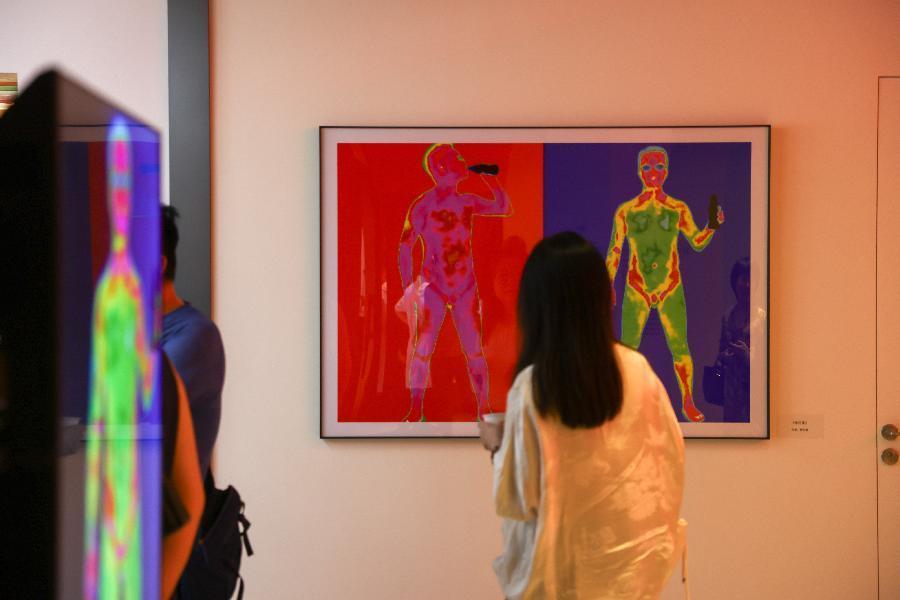
On August 13th, artist Zeng Yicheng 's solo exhibition, "Eight Section Brocade ", opened at the Li Ke Study of the Hangu Traditional Chinese Medicine Clinic in Tianhe District, Guangzhou . The works on display were created by infrared thermography, a tool typically used in medical research. The pieces focus on health and bio-inspired practices related to traditional Chinese medicine (TCM), such as the Eight Section Brocade and the Five Mimic-animal Exercises , representing the artist's exploration of the intersection between TCM and art.

Dating back to the Song Dynasty, the Eight Section Brocade is a practical application of the health principles of TCM, with each movement serving a specific therapeutic purpose. It is designed to enhance physical strength and prevent illness. The name Eight Section Brocade refers to the smooth, flowing, and elegant nature of the exercises, compared to the softness and beauty of brocade fabric, aiming to "align the bones, relax the muscles, and promote the flow of qi and blood ".

Zeng Yicheng used infrared thermography , a medical research tool, for shooting and creation. This instrument employs eight colors to represent temperature variations: deep red, red, light red, yellow, green, light blue, dark blue, and black. These colors illustrate the body's warmth, coldness, and the flow of qi and blood, reflecting the traditional essence and appeal of Eight Section Brocade through contemporary technology. The exhibition "Eight Section Brocade" has recently been selected for the Experimental Art, Digital Art, and Animation sections of the 14th National Exhibition of Fine Arts .
In brief, Zeng Yicheng utilized an infrared thermograph for shooting and creation. The infrared camera employs eight colors to represent temperature distribution.
The work "Five Mimic-animal Exercises" is presented in photographic form, depicting movements that simulate the tiger, deer, bear, monkey, and crane using eight colors from infrared thermography. Originating in the Eastern Han Dynasty , during a period of significant development in TCM, it is said to have been created by Hua Tuo, with the combination of dynamic and static bionics, requiring practitioners to embody both form and spirit.

The organizer stated that this exhibition invited viewers to reflect on the intersection of art and Chinese traditional health practices through TCM's artistic presentation. The exhibition will run until August 30th.
Source :Yangcheng Evening News
当艺术遇上中医,会碰撞出怎样的火花?
8月13日,艺术家曾忆城个人展览《八段锦》在广州汉古中医天河馆李可书房展出。展出的作品采用医学研究用的红外热成像仪器来进行拍摄创作,创作内容围绕着与传统中医相关的八段锦、五禽戏等养生、仿生功法展开,是艺术家关于中医与艺术的探索。
始于宋代的八段锦是中医养生智慧的实践运用,“一个动作一味药”,强身健体,预防疾病。八段锦之所以得名是因为整套动作如锦缎般柔和连绵、流畅华美,“骨正筋柔,气血以流”。
曾忆城用医学研究用的红外热成像仪器来进行拍摄创作,红外热成像仪使用八种颜色来表示温度的分布,依次为深红、红、浅红、黄、绿、浅蓝、深蓝和黑色。人体的寒热温凉、气血流转通过这八种如锦似缎的色彩呈现了出来,用当代新技术探索、呈现这套传统经典功法的内涵与魅力。据悉,《八段锦》刚入选第十四届全国美术作品展览实验艺术、数字艺术与动画展区。
曾忆城用医学研究用的红外热成像仪器来进行拍摄创作,红外热成像仪使用八种颜色来表示温度的分布。
作品《五禽戏》则以照片的形式呈现,通过红外热成像技术八种色彩所描绘出人模拟虎、鹿、熊、猿、鹤五种动物的动作。五禽戏始于东汉,正是中医药发展集大成的时期,相传由华佗创立,是一项动静兼备的仿生功法,要求练习者追求形神兼备。
主办方表示,本次展览的作品通过对中医的艺术化展示,邀请观众一起思考艺术与中国传统健康生活方式。展览将持续至8月30日。
采写|新快报记者 许婉婕
翻译|肖凯欣
英文审校|赵凡
-
Witness Good Fortune! Up-Close Encounter with Chinese White Dolphins in Zhanjiang
2024-08-16 12:28:19 -
中华白海豚你知多少?跟CC一起探秘吧!
2024-08-16 00:13:33 -
Poster丨Roast Goose Feast Spices Up the Summer
2024-08-15 22:50:18 -
Large documentary series launched to tell the centennial story of Lingnan Traditional Chinese Medicine
2024-08-16 00:13:33






